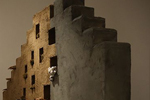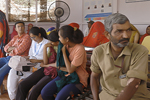Mapping the Sea: Ecologies, Communities, and Consumption
By Parag Tandel x Tarq

Parag Tandel's practice is rooted in his identity as a member of Mumbai's early coastal inhabitant community, the Koli. The Koli community value a special relationship with water, as a life-giving source, site of purification, cyclical life, and ancestral wisdom. Urban expansion and development inevitably affect water temperature and marine ecology. His inquiry into his community’s history and contemporary times has resulted in an archive of past chronicles, local myths, deities, indigenous marine life, and staple Koli recipes.
VITAMIN SEA, COASTAL ROAD PROJECT 3
Though otherworldly in appearance, this sculpture is Tandel’s representation of a particular marine organism, the plankton. These microscopic organisms are vital to marine ecosystems and are the main food source for whale sharks, which the Koli community reveres as Bahiridev, a sea deity never hunted. But climate change and urban development are disrupting this delicate balance. As plankton populations decline, so do the whale sharks. Through his art, Tandel voices a powerful protest, calling attention to the deep cultural and ecological ties between coastal communities and the sea, and urging us to rethink how we care for our marine environments.
HOW TO COOK 'BOMBAY' DUCK IN VARIOUS WAYS
This sculpture confronts and memorializes the Bombay Duck fish. The fish was once an icon of Mumbai's coastal waters, but is now a symbol of loss. The population of Bombay Duck is drastically decreasing due to warmer ocean temperatures caused by climate change, forced to migrate to cooler
areas, and overfishing. The artwork depicts Mumbai's current landscape using an older map of its original islands, featuring racks filled with Bombay Duck and motifs of local marine life on the floor.


